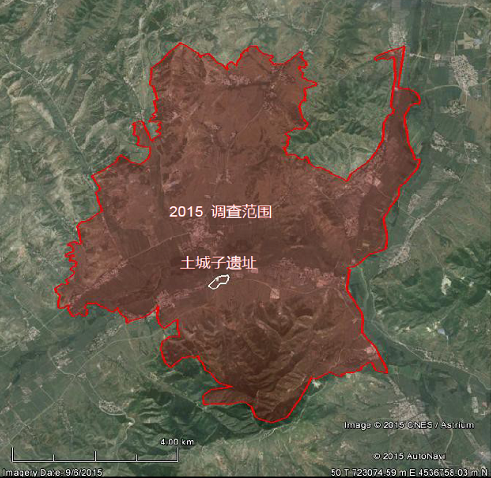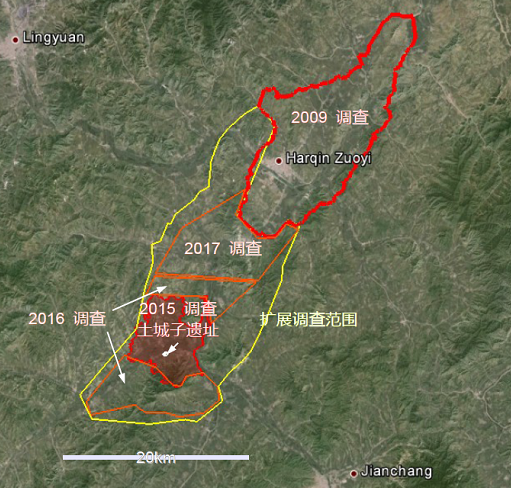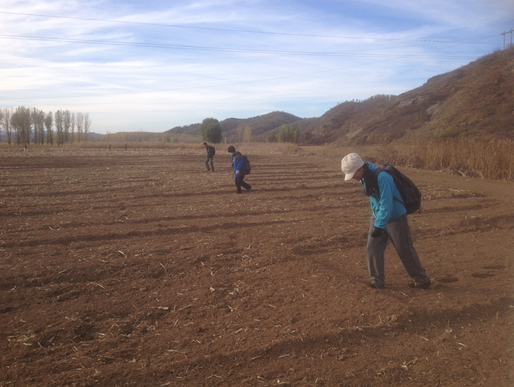
| 热门信息 | |
| 铿锵四人行:“以法律保护文化... | |
| 新疆唐朝墩古城遗址2021年... | |
| 讲座预告 | 《文化遗产保护... | |
| 征稿 |《北方民族考古》(第... | |
| 新书推荐 |《蒙古及周边地区... | |
| 中国人民大学历史学院考古文博... | |
| 居延文化研究中心组织专家组考... | |
| 讲座纪要|中国人民大学考古文... | |
| 最新信息 | |
| 铿锵四人行:“以法律保护文化... | |
| 新疆唐朝墩古城遗址2021年... | |
| 讲座预告 | 《文化遗产保护... | |
| 征稿 |《北方民族考古》(第... | |
| 新书推荐 |《蒙古及周边地区... | |
| 中国人民大学历史学院考古文博... | |
| 居延文化研究中心组织专家组考... | |
| 讲座纪要|中国人民大学考古文... | |
| 考古发掘 | |
| 新疆唐朝墩古城遗址2021年... | |
| 2021年唐朝墩古城遗址考古... | |
| 2020年唐朝墩古城遗址考古... | |
| 2020古北口五里坨段长城遗... | |
| 2020年唐朝墩古城遗址考古... | |
| 顶酷热——慈城考古进行时 | |
| 2020年吉仁台沟口遗址考古... | |
| 2020年宁波慈城东门村遗址... | |
2015 Tuchengzi Archaeological Settlement Survey
Major Goals
The major goal of the project this year was to investigate the regional context of the Tuchengzi archaeological site. (Fig 1). This site dates to the Early Bronze Age (2000 to 1200 BCE) and is currently being excavated in conjunction with the survey. Specifically, the goals were to establish the evidence for prior habitation during the Hongshan Period (4500 to 3000 BCE) and locate archaeological sites from the same period in different environmental zones.

Fig 1
The survey was largely successful in achieving this year's goals. Future efforts will focus on exploring territory further to the north and south. (Fig 2). These areas will further our understanding of population dynamics and social structure during the Hongshan period as the survey meets the territory explored in 2009 around Dongshanzui. Futhermore, these regions will expand and diversify the environments exploited by Bronze Age societies.

Fig 2
Regional settlement survey is draws on the theory and methods developed over the past fifty years. It has been successfully employed to understand changes in social organization, subsistence economics and ideology over long periods of time at a regional scale. The social organization and economic exploitation of this region is especially of interest to this project and survey. The Early Bronze Age witnessed a decisive growth in population. It is assumed that socioeconomic institutions would change or be created to coincide with the growth in population. The larger goal of the project is to better understand the processes of socioeconomic change.
Major Activities/ Accomplishments
Systematic regional archaeological survey was carried out in Kazuo, Liaoning Province, completely covering a contiguous area of approximately 51 sq km. Teams of three or four archaeologists walked systematically across the landscape, along transects separated at intervals of between 30 and 50 m, following landscape features and searching for artifacts on the surface. (Fig 3) When an artifact was encountered by any member of the team, he or she informed the other members. If at least two artifacts were encountered by the survey team within 50 m of each other, then a collection was made. The locations and boundaries of artifact scatters were recorded and drawn on 1:5000 prints of 5 m resolution satellite imagery. Areas of the artifact distributions were also recorded on survey forms. For any surface scatter larger than about 0.25 ha (50 m by 50 m), the area was subdivided into separate collection units roughly 0.25 ha each. If sherd densities appeared greater than 0.5 sherds per sq m, a systematic collection was made of all artifacts within a circle with a radius of 1.8 m (10 sq m). If the systematic collection did not yield 30 sherds, then subsequent systematic collections were made until the sample size of 30 was reached or five systematic collections were made. Using these methods, 1439 units were collected; 53 of the lots had densities high enough to necessitate systematic collection. At the end of each day artifacts were cataloged, data from lot forms were entered into an electronic spreadsheet, and the spatial limits of collection lots were redrawn into a digital map. Artifacts were analyzed at the Kazuo, Tuchengzi work station and the archeological laboratories at Renmin University. Ceramics were classified according to the region's pre-existing chronological framework, so as to associate relative dates to prehistoric settlement.

Fig 3
GIS (Geographic Information Systems) analysis of the locations of settlement will establish the relationship between settlements and local resources. The settlement distribution from each period can be compared to the locations of rivers, soil types and landforms to access the importance of these variables in determining settlement location.
Microscopic use-wear analysis will be conducted on the stone tools found in 43 of the survey collections to begin to understand the nature of some of the subsistence pursuits within communities during these periods. This analysis will yield direct evidence of the cutting of agricultural grasses, the butchery of animals, the processing of hides and woodworking associated with some of the collections described above.
Significant Results/ Outcomes
In the earliest period represented in Kazuo (4500 to 3000 BCE), a single small settled farming hamlet in the northern part of the study area represents the settlement pattern. Future research will focus on how these patterns change as the survey zone moves north and closer to the large settlements found around the Dongshanzui site (4500 to 3000 BCE). The period between 3000 and 2000 BCE is very poorly known all across northeastern China. It is unclear whether this lack of evidence results from substantial depopulation or lack of sufficient knowledge of domestic ceramics to make possible the recognition of its remains.
In the ensuing Early Bronze Age (2000 to 1200 BCE), based on the number of ceramics recovered, the population of the study area seems to have increased. Large sites, including Tuchengzi, are found in other parts of the landscape. This is not unlike the results found in other areas of Northeast China. For example, population growth was also found in the northern part of Kazuo county, Zhangwu county and in the region surrounding the city of Chifeng in Inner Mongolia. If the results continue to be similar to other regions we can expect single local communities that may have contained more than 1,000 inhabitants and larger social communities in the several thousands.
Following this demographic expansion, the Late Bronze Age (1200 to 600 BCE) is characterized by population levels which are roughly equivalent to the Early Bronze Age, if ceramic counts can be used as a proxy for population. By comparison, at this point in the sequence, the northern part of Kazuo county and the Chifeng region have the highest population levels of the entire prehistoric and early historic trajectory. While much of the region is made up of large dense sites throughout the Bronze Age, a number of small dense sites were located on hilltops and ridges. The precise nature of these sites remain unclear, however their role as lookouts and beacons is a promising hypothesis to be tested.
Through analysis of the location of settlements as well understanding the visibility at these locations we will be able to test this notion.
The number of ceramics from the next period (600 BCE to 200 AD) indicate that there is a substantial sedentary population in the region. This is in contrast to the presence of specialized mobile herding that is well documented by historical accounts. The emergence of this subsistence specialization was thus limited to other macro-environments at least during this period.
Training
This research is part of the undergraduate field school, the project provided essential training for the students. The students participated for about one month of fieldwork and laboratory artifact analysis. They received training in systematic, regional-scale survey, including the use of GPS technology and satellite imagery, different methods of artifact recovery, and GIS and other computer applications. One graduate student also participated, gaining experience in the field methods and logistical concerns of regional-scale survey projects.
Physical Collections
Physical collections of ceramic and stone artifacts recovered in the survey are curated by the Kazuo County Museum, where the collection is accessible to researchers under the established policies of the Liaoning Province Institute of Archaeology.
Databases
A complete registry of the areas of ancient occupation in the study area provides a spatial database linked to detailed data from the analysis of artifacts recovered from the different collection units. These data will be presented in full at the completion of the project. This will be a resource that graduate students can draw from in the future.
Impact on the Principal Discipline
The impacts of this project on the field of archaeology will be of interest to both regional and topical specialists. The relationship between environment, settlement and economics has been central to theories about prehistoric social dynamics. Furthermore, historical accounts of the political and economic dynamics of early Chinese states has been studied for hundreds of years, and archaeologists have more recently joined in this emphasis. The nature of these relationships both in prehistory and later periods, however, have never been at all well understood or even documented. The project provides an opportunity to establish specific details on these issues while maintaining a regional scale of analysis. These same issues arise for archaeologists studying early complex societies all across Asia, as well as much of the world, where demography and subsistence economics has played a substantial role in complex socio-political organization.
| 友情链接 |
|